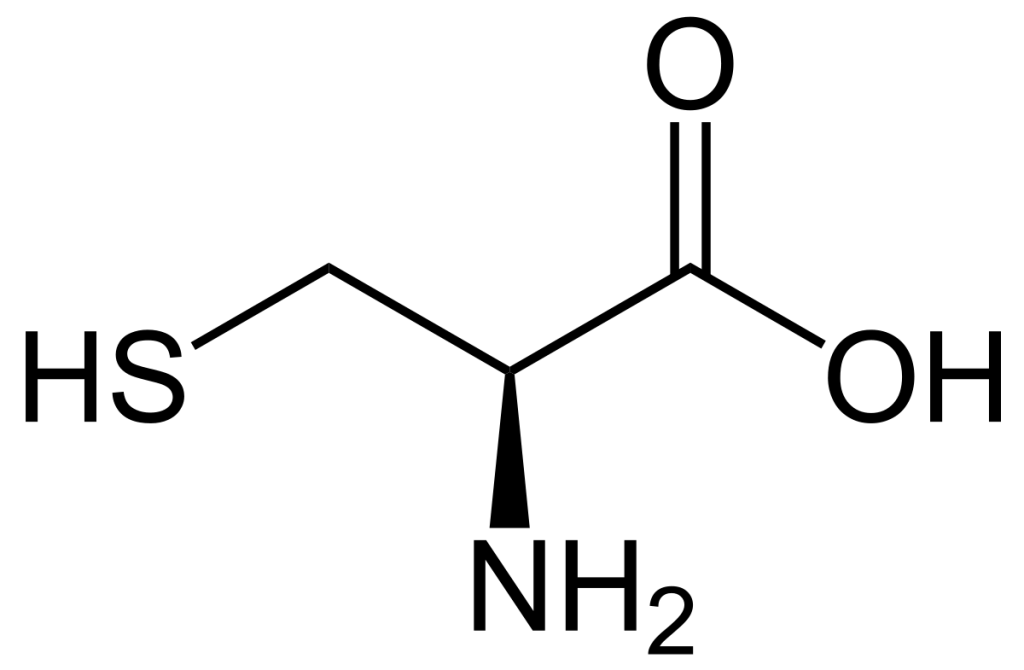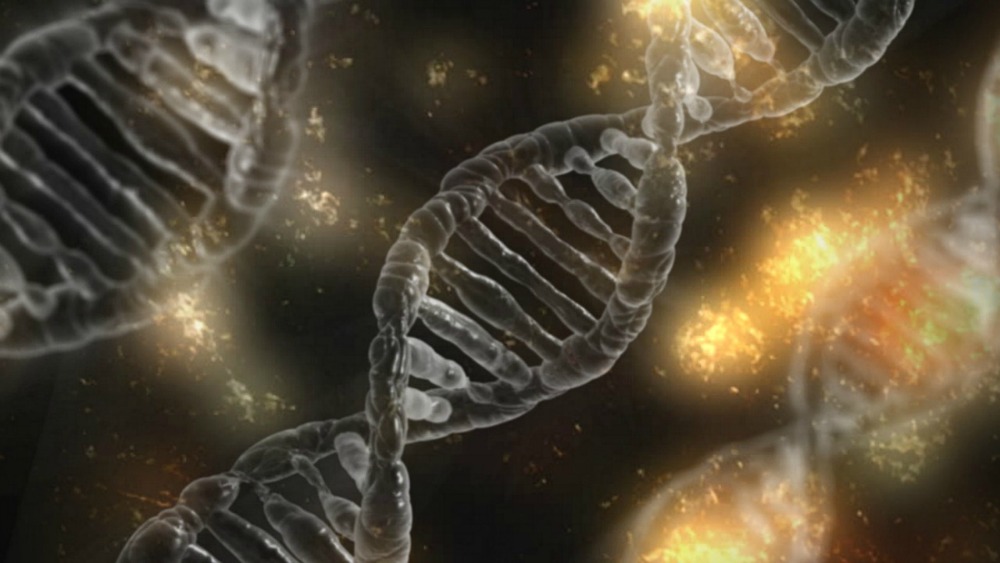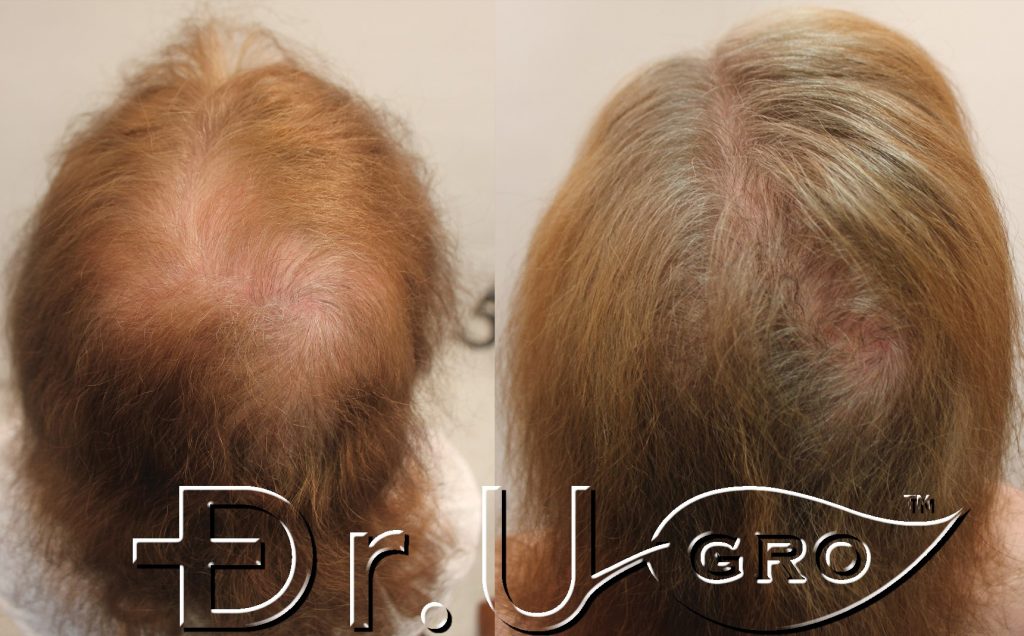What is L-Cysteine?
Cystine is one of the 22 amino acids that our bodies need to build proteins. We can either synthesize it ourselves or derive it from food sources. Two L-cysteine molecules produce another essential amino acid known as cystine. Cystine is also used to help form the structure of nails, skin, and hair. First, however, it needs to be converted into a form known as L-cysteine, which the skin can use. Researchers are now designing controlled studies to investigate the role of L-cysteine for hair growth.

Sources of L-Cysteine for Hair Loss
The body can produce L-cysteine for hair growth in small quantities on its own. It is also possible to derive this amino acid from food sources. There are foods rich in cysteine, which is broken down into L-cysteine. These include:
- Soy
- Couscous
- Red winter wheat
- Spelt
- Durum wheat
- Oat bran
- Barley
More direct sources of cysteine include:
- Sprouted lentils
- Brussel sprouts
- Red peppers
- Garlic
- Onions
- Broccoli

The Roles of L-Cysteine and L-Cysteine to Grow Hair
L-cysteine is found in the form of the cysteine amino acid, which our skin can readily utilize. It is a sulfur-rich compound that our hair follicles need for manufacturing our hair shafts. According to the Journal of Applied Cosmetology, the basic role of L-cysteine for hair growth is to energize, stimulate, and revitalize the hair strands’ developmental process and nail growth. Since L-cysteine is a building block of cystine, it will help to learn about the fascinating research studies that discuss each of these compounds to understand how and why they are necessary for the follicles to perform best in terms of hair health, hair growth, or hair restoration.
How L-Cysteine Combined With Retinol Improved Diffuse Hair Loss
Hauztartzt published a pilot and a double-blind research study led by researchers Hertel H, Gollnick H, Matthies C, et al. on using L-cysteine and retinol to reverse diffuse hair loss by lowering the telogen rates of the hair follicles (1). Telogen is the stage of the hair life cycle when the follicles are in their resting state. The anagen phase, on the other hand, is when the follicles are actively producing hair. In many instances of hair loss, there is a much higher percentage of follicles in the telogen stage.
The pilot study focused on 36 subjects. Following their treatment with L-cysteine and retinol supplementation, the participants experienced an 11% increase in anagen rates, along with a reduction in telogen rates by 8.3%. The research group then followed up the pilot study with a double-blind study. This study included a placebo, along with the L-cysteine and retinol treatment tested. Neither the researchers nor the subjects knew which intervention was administered, whether it was the placebo or the supplements. The subjects initially displayed an average baseline diffuse hair loss state, quantified as a 47.2% anagen rate. Following the treatment with the L-cysteine and retinol combination, this percentage increased by 8%. The placebo group did not experience any changes. Based on these statistics, the researchers concluded that diffuse hair loss conditions might benefit from high dosages of L-cysteine and retinol on a long-term treatment basis.
L-Cysteine Improvements for Hair Growth May Be Due to a Calcium Binding Protein on the Hair Follicle
Researchers Kizawa K Tsuchimoto S. Hashimoto K et al. identified a gene called S100A3, which codes to construct a calcium-binding protein on the hair follicle (2). This protein is rich in L-cysteine. These scientists were interested in observing the gene expression of S100A3 during the anagen growth phase of the hair follicle, as well as the regression phase. They also wanted to know where this gene expression tended to occur within the follicle and the possible role of the calcium-binding protein in the process of forming new hair.
The researchers cloned a mouse with the S100A3 gene. They observed the mRNA levels, which bound to the gene sequence, and started the process of putting amino acids such as L-cysteine for hair growth together in the correct arrangements to build the final protein. They found that the mRNA levels increased during the anagen hair growth phase while decreasing during the regression phase. Additionally, they discovered that gene expression was occurring in follicular cells in the process of differentiating into more specific cells needed to build the hair shaft. The researchers believe that the protein made from the S100A3 gene is responsible for calcium-dependent processes critical during the construction of hair shafts. Therefore, the amino acid L-cysteine is an essential contributor to hair growth and is necessary for the hair follicles to utilize calcium to build hair strands.

L-Cysteine and Vitamin B6 Prevent Chemo-Related Alopecia in Mice
Hair loss, for the most part, is an inevitable part of chemotherapy in most cancer patients. To help solve this issue, researchers D’Agostini F Bagnasco M, Giunciuglio D. et al explored the roles of L-Cysteine and Vitamin B6 in preventing this type of alopecia from occurring (3). They exposed mice to certain conditions to cause tumors to develop. The rodents were then treated with chemotherapy to induce baseline states of hair loss that the researchers could quantify. However, when given various dosages of L-Cysteine and Vitamin B6, the scientists found that this supplementation inhibited the alopecia on the backs of the mice. The extent to which this phenomenon occurred was dosage-dependent. In a similar study, D’Agostini F and Ganchev G tested the effect of L-Cysteine for hair loss by inducing tumors in mice using benzo[a]pyrene (4). This process led to a spontaneous form of alopecia areata. The researchers then administered two types of treatments, either budesonide or N-acetyl-L-cysteine, which successfully inhibited hair loss.
L-Cysteine For Hair Growth Inhibits the Androgenic Alopecia Factor, TGF-B1
Male pattern baldness, also known as androgenic alopecia, results from a combination of many different biochemical pathways. The most well-known pathway related to male pattern baldness is the conversion of testosterone to DHT. Those with the genetic predisposition to MPB will have weaker (i.e., more sensitive) DHT receptors on their hair follicles. The binding of DHT to these receptors will start a chain reaction of processes that cause the follicles to miniaturize. Hair will become thinner and eventually stop growing.
Besides the formation of DHT, a lesser-known pathway also contributes significantly to androgenic alopecia. This pathway is the production of TGF-B1, which promotes the continued progression of hair loss. In 2013, a group of researchers, Shin H, You HG, Inui S et al., designed an experiment to create conditions in mice models to allow them to observe the pathways that lead to increased TGF-B1 secretion and suppress it using NAC (N-acetyl-L-cysteine) (5). Once they managed to induce the production and release of TGF-B1, they were interested in testing a possible treatment, the use of NAC, to see if this could combat hair loss by suppressing TGF-B1. NAC is a version of cysteine that allows the body to produce an important anti-oxidant, glutathione.
The scientists first transfected rat derma papilla cells (DP-6) with androgen receptors to enact their strategy. The next step introduced androgens into the animals’ models that would then bind to these receptors. The binding of the androgens prompted the increased production of ROS (reactive oxidative species). This increased production of ROS, in turn, activated the TGF-B1 compound, which was then secreted in much larger quantities by the derma papilla cells. After eliciting the TGF-B1, the next phase of the study was to see if N-acetyl-cysteine could suppress the TGF-B1. NAC acted as a scavenger of the ROS. Reduced levels of the reactive oxidative species helped reduce the TGF-B1 secretion. This finding supported the effectiveness of N-acetyl-L-Cysteine and the skin-ready form L-cysteine for hair loss in mice animal subjects.

L-Cysteine For Hair Loss In Guinea Pigs
In 2014, Chatterjee D, Mukherjee S., Smith M et al. induced hair loss in guinea pigs by exposing them to a mustard gas analog, chloroethyl ethyl sulfide (CEES)(6). As a result, the hair of these animal models developed a rough, dry texture and fell. When the guinea pigs were treated with N-acetyl-L-cysteine before being exposed to the CEES, they did not experience hair loss.
Researchers Eliminate Proteinase of L-Cysteine For Hair Growth
A group of scientists, Roth W. Deuss J. Botcharev et al., were interested in learning more about the role of L-cysteine for hair growth processes (7). They designed an experiment to see what would happen if the body could not produce an L-cysteine protein structure, known as Cathepsin L (CTSL). However, instead of performing tests on humans, they used mice subjects instead. The researchers deactivated the CTSL gene in the animal models (i.e., knockout mice). Without the ability to produce the Cathepsin proteinase, this mutation caused the mice to lose hair periodically and develop other conditions, such as acanthosis, hyperkeratosis, and epidermal hyperplasia.
The researchers examined how the absence of the CTSL proteinase changed the mice’s hair follicles. They discovered the following alterations in the morphogenesis of these structures:
- Dilated hair follicle canals
- Distorted club hair formation (i.e., dead hair, which is the final product of the hair follicle during the telogen resting phase)
- Hyperproliferation of the epithelial cells and the basal epidermal keratinocytes within the hair follicle
The researchers concluded that the CTSL proteinase is essential for developing normal hair follicles based on these observations. L-cysteine for hair growth contributes to the structure of this protein. Likewise, it provides a critical basis for the healthy development of follicles.
Another Study of L-Cysteine For Hair Growth
A similar study was conducted by Benevides F. Starost MF, Flores M, et al. (8). This research team also produced knockout mice by eliminating a gene sequence to create a deficiency in cathepsin-L. In this study, the missing proteinase also affected the morphogenesis of the hair follicle. The researchers observed a general overall delay in the formation of follicular development and the onset of the initial catagen phase. The mice also showed abnormalities in epidermal differentiation, with mild forms of hyperplasia (i.e., increase in cell reproduction rates) and hyperkeratosis (i.e., thickening of the outer skin).
Human Enzyme Made of L-Cysteine To Grow Hair Normally in Cathepsin-L Deficient Mice
Researchers Hagemann S, Gunther T, Dennermarker T, et al. also worked with knockout mice with the gene code for cathepsin-L removed from their DNA (9). They identified a comparative human enzyme protein, where 75% of the protein sequences match the murine cathepsin-L. This human protein version is known as cathepsin V or cathepsin L2. The research team inserted the gene instructions for this compound into the DNA of the knockout mice to see if this might improve the skin and hair to normal conditions. As previously noted, when knockout mice are deficient in cathepsin-L, they display periodic forms of hair loss and aberrant epidermal differentiation. When the researchers inserted the new genetic code for human cathepsin V into the animal subjects, they noticed the restoration of hair growth and texture and standard developments in epidermal thickness.

Does L-Cysteine Have Side Effects?
At the moment, there are no standard dosages for taking L-Cysteine capsule or powder supplements. However, your doctor can make appropriate recommendations for your specific health needs. Children should not take NAC (N-acetyl-L-cysteine) except under the supervision of a pediatrician.
Interactions With Medications
L-cysteine may interact adversely with drugs that are intended to suppress the immune system. Examples include Prednisone (Deltasone), Cyclophosphamide (Cytoxan) Azathioprine (Imuran). Another group of prescription medications to be wary of include chest pain drugs such as Isosorbide (Isordil) nitroglycerin (Rectiv, Nitro-Time, Nitrolingual, Nitrostat, and GoNitro). Possible side effects may result, such as severe headaches and low blood pressure. The topical use of NAC may intensify the effect of an antifungal athlete’s foot drug known as oxiconazole (Oxistat). Be sure to speak to your doctor about the possibility of this drug interaction. And finally, use caution when taking activated charcoal with NAC. Charcoal is generally used to remove toxins and other unwanted substances to improve kidney filtration issues, intestinal gas, water filtration, diarrhea, body odor, skin infections, and oral health. NAC may weaken the effects of activated charcoal.
Safety Rating
The Environmental Working Group assigned cysteine a green safety rating of “fair.” While it has no link to cancer, developmental or reproductive toxicity or allergies, and immunotoxicity, the FDA recommends its limited usage in food. However, it is considered generally safe for consumption. Cysteine is non-toxic to our (non-reproductive) organs. Nor will it accumulate or persist in our bodies.
Other Uses of L-Cysteine
Besides improving the health of our follicles, studies also show that L-cysteine can strengthen our immune system functioning by boosting our glutathione levels. Potential applications include HIV patients and post-menopausal females. More so, L-Cysteine may offer beneficial detoxification effects. By restoring glutathione levels, our bodies are better able to fight the oxidative effects of toxic metals.
Dr.UGro Gashee Products have been clinically tested to help promote hair growth. All products contain the right amount of cystine for optimal hair growth, along with other plant-based all-natural ingredients. If you are interested in taking cystine for healthier hair, visit our shop.
Dr.UGro Gashee Oral Supplement With L-Cysteine Helped This Woman Regrow Her Hairline
Laura was suffering from hair loss. Her hair was patchy, sparse, and brittle. According to her, her hair lost its fullness and life as the days went by. Laura had attributed the loss of hair fullness, hair breakage, and her hair dullness to her menopause - she reported that after menopause, her hair had lost its luster. She searched far and wide for products to revitalize her hair. Now, this is where Dr.UGro’s All-Natural Hair Growth & Restoration comes in to save the day:

Before and after Laura’s hair growth and transformation, side-by-side comparison - seen in just 3 months of using Dr. UGro’s Gashee Hair Growth Products. Fortunately, Laura’s story had a happy ending. After 3 months of consistent use of Dr. UGro’s Gashee all-natural hair growth and restoration products, she was able to see and feel her hair growing back, regaining the luster that she had once lost to menopause. Today Laura reports that she is happier than ever, feeling more confident than ever with her hair.
Frequently Asked Questions on L-Cysteine for Hair Growth
Does L-cysteine help hair growth in people? Although more human studies are needed, is it still ok to use L-cysteine to grow hair?
L-Cysteine is used to facilitate the hair growth processes conducted by hair follicles. Two cysteine molecules can combine to form cystine, which is more crucial for building the hair shafts. As the studies above suggest, L-cysteine for hair growth may inhibit TGF-B1. This mechanism of action may be effective against pattern baldness. It may also be that L-cysteine is necessary for the regular and healthy development of hair follicles. Yet, further testing on human subjects is a necessary step to generalize these findings to people. In the meantime, if you are interested in consuming more L-cysteine in your diet, consider food sources or supplementation under the advice of your physician. You may also want to consider topical forms of treatment that offer effective skin penetrants to deliver the amino acid better. Hair growth, however, is not a guaranteed result.
Will taking L-Cysteine for human hair improve its texture and sheen?
L-Cysteine molecules combine to form cystine, and this amino acid is essential for building your hair’s keratin structure. When you decide to incorporate a new supplement into your diet, it is best to speak to your physician. Otherwise, you may want to consider eating food sources rich in this nutrient or use an effective topical product containing cysteine. Improving the texture, sheen, and strength of your hair will be contingent on many factors. Increasing your L-Cysteine intake may have varying effects on different individuals.
What is the recommended L-Cysteine dosage for hair health?
The minimum recommended dosage for daily L-cysteine intake is 1400mg. Supplement tablets usually range from 200-500mg. Your doctor can provide dosage levels that would be safe and effective for your body.
What are the side effects of consuming too much L-Cysteine?
The side effects of consuming excessive L-cysteine for hair growth include nausea, diarrhea, constipation, rashes, fever, low blood pressure, headaches, vomiting, and liver complications. Carefully formulated topical products containing L-cysteine (with the aid of safe, effective skin-penetrating compounds) can help prevent the occurrence of toxicity from taking excessive doses orally, providing a more direct route to the hair follicles themselves.
References
(1) Hertel H, Gollnick H, Matthies C, et al. Low dosage retinol and L-cysteine combination improve alopecia of the diffuse type following long-term oral administration. [Article in German] Hautarzt 1989;40(8):490-5.
(2) Kizawa K, Tsuchimoto S, Hashimoto K, et al. Gene expression of mouse S100A3, a cysteine-rich calcium-binding protein in developing hair follicle. J Invest Dermatol 1998;111(5):879-86.
(3) D’Agostini F, Bagnasco M, Giunciuglio D, et al. Inhibition of oral N-acetylcysteine of doxorubicin-induced clastogenicity and alopecia, and prevention of primary tumors and lung micrometastases in mice. Int J Oncol 1998;13(2):217-24.
(4) Balansky R, D’Agostini F, Ganchev G. Influence of FHIT on benzo[a]pyrene-induced tumors and alopecia in mice: chemoprevention by budesonide and N-acetylcysteine. PNAS 2006;103(20):7823-8.
(5) Shin H, You HG, Inui S, et al. Induction of transforming growth factor-beta 1 by androgen is mediated by reactive oxygen species in hair follicle dermal papilla cells. BMB Rep 2013;46(9):460-4.
(6) Chatterjee D, Mukherjee S, Smith M, et al. Evidence of hair loss after subacute exposure to 2 chloroethyl ethyl sulfide, a mustard analog, and beneficial effects of N acetylcysteine. J Biochem Mol Toxicol 2004;18(3):150-3.
(7) Roth W, Deussing J, Botcharev VA, et al. Cathepsin L deficiency as a molecular defect of furless: hyperproliferation of keratinocytes and perturbation of hair follicle cycling. FASEB J 2000;14:2075-86.
(8) Benavides F, Starost MF, Flores M, et al. Impaired hair follicles morphogenesis and cycling with abnormal epidermal differentiation in nackt mice, a cathepsin L-deficient mutation. Am J Pathol 2002;161:693-703.
(9) Hagemann S, Günther T, Dennermarker T, et al. The human cysteine protease cathepsin V can compensate for murine cathepsin L in mouse epidermis and hair follicles. Eur J Cell Biol 2004;83(11-12):775-80.





